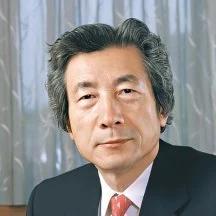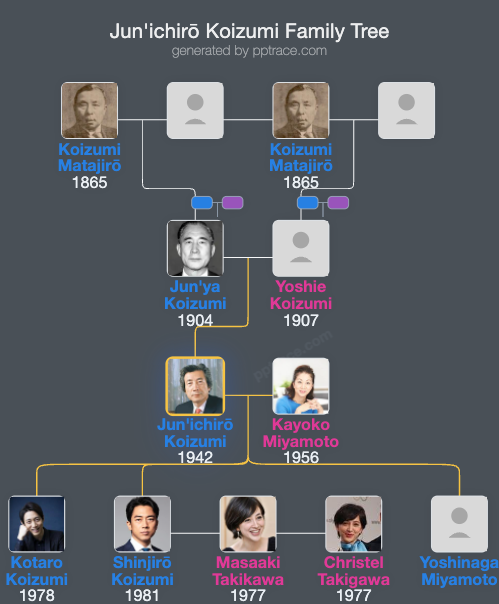
Jun'ichirō Koizumi
| Name | Jun'ichirō Koizumi |
| Title | Prime Minister of Japan from 2001 to 2006 |
| Gender | Male |
| Birthday | 1942-01-08 |
| nationality | Japan |
| Source | https://www.wikidata.org/wiki/Q130852 |
| pptrace | View Family Tree |
| LastUpdate | 2025-10-05T07:02:52.745Z |
Introduction
Junichiro Koizumi was born on January 8, 1942, in Yokosuka City, Kanagawa Prefecture, Japan. His family has a strong political background; his grandfather, Koizumi Yojirō, and his father, Koizumi Junya, both served as Cabinet Ministers in Japan. Among his family members, great-grandfather Koizumi Yūbei laid the foundation for the family's involvement in military and political fields.
Regarding his education, Junichiro Koizumi graduated from Yokosuka Municipal Yamasaki Elementary School in 1954, and from Yokosuka Municipal Mabori Junior High School in 1957. In 1960, he graduated from Kanagawa Prefectural Yokosuka High School. He then applied to the University of Tokyo but was unsuccessful; instead, he entered Keio University’s Faculty of Economics. After graduating in 1967, he studied abroad at the University of London in the United Kingdom.
In August 1969, his father, Junya Koizumi, passed away, prompting Koizumi to suspend his studies and return to Japan. The following year, in December 1969, he ran for the Japanese House of Representatives in a Kanagawa constituency but was defeated due to lack of preparation. Subsequently, he became a secretary to Takeo Fukuda. In 1972, with Fukuda’s support, Koizumi was elected to the House of Representatives for the first time and was re-elected multiple times thereafter.
In government, Koizumi held several key positions, including Minister of Health and Welfare and Minister of Posts and Telecommunications. In December 1988, he served as Minister of Health and Welfare under Prime Minister Toshiki Kaifu’s cabinet. In December 1992, he became Minister of Posts in Prime Minister Kiichi Miyazawa’s cabinet and promoted structural reforms, including postal privatization. In 1995, he first ran for president of the Liberal Democratic Party (LDP), gaining widespread attention even though he did not win. He ran again for the party leadership in 1996 and 1998. Following the death of Prime Minister Keizō Obuchi in 2000, Koizumi was elected as the head of the LDP’s Mori faction.
In April 2001, Koizumi announced his resignation as head of the Mori faction and campaigned under the slogan "Reforming the LDP, Reforming Japan," winning the LDP presidential election. On April 26, he became Japan’s 87th Prime Minister, marking the peak of his political career. He was re-elected as party president in 2003 and subsequently became Prime Minister in November of that year. During his three consecutive terms, he promoted major policies such as postal privatization and economic structural reforms.
In September 2006, Koizumi stepped down as Prime Minister, succeeded by Shinzo Abe. After stepping back from active politics, he engaged less in political affairs and focused on personal interests and public projects. In September 2008, he announced his retirement from politics, transferring his political assets to his second son, Jun’ichirō Koizumi. In 2013, Koizumi supported anti-nuclear movements, founding the “Natural Energy Promotion Society” to continue advocating for a "zero nuclear power" goal.
Junichiro Koizumi’s political style centered on reform, driving profound changes in Japan’s economy and society. He had a significant impact in diplomacy, economics, and military policy. His activities and policies garnered widespread attention both domestically and internationally.
Family Tree
Tap to expand more relatives
